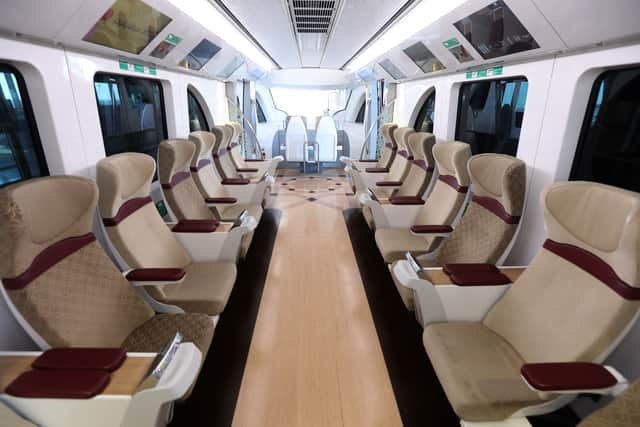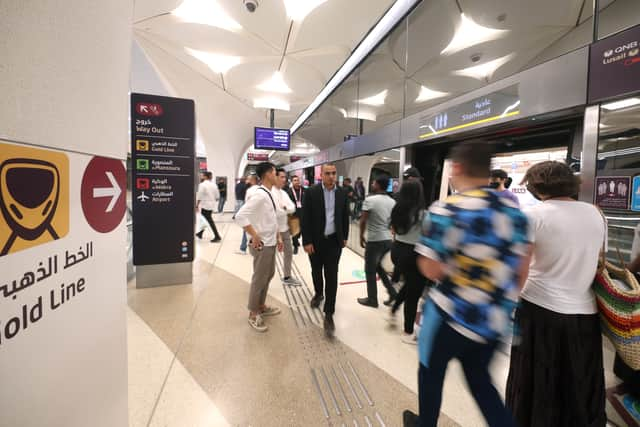Rahman Osman’s World Cup diary: riding the rails on Qatar’s underground metro system
and live on Freeview channel 276
Qatar has invested almost £220 billion into hosting the World Cup and for many it is one that still divides opinion - from the timing to the human rights and LGBTQ+ issues. There is an air of uncertainty that hovers around the tournament, as these tensions remain at the forefront of people’s minds.
The game between German and Japan highlighted the political issues with the German team choosing to put their hands on their mouths in group picture, in response to the last minute decision from FIFA to threaten sanctions if the rainbow coloured armband was worn by the seven European countries who intended to do so.
Advertisement
Hide AdAdvertisement
Hide AdThe German FA say human rights issues are non-negotiable, while the Arab world claims that when you come to visit them, you must respect their laws, culture and way of life. These two issues continue to dominate the front page headlines.
Far away from this tension, deep beneath the city, there are three newly constructed lines that cut Qatar into two halves. If you are a fan here at the World Cup or work in the media, it’s best to get used to the lines to improve your experience of the tournament. Here is all you need to know about the lines and what to expect from those at the stations. Remember with your Hayya card, it’s free transport:


The Red line
This line is quite special to me as I’m regularly on it. Starting from Lusail, 14 miles north of the centre of Doha, it cuts through the city all the way to Al Wakra, the second biggest city in Qatar. Coincidentally that is where the England training camp and media bubble is located.
In between these two extremes, you’ll pass through places like Decc, Coniche and Ras Abu, all notable locations in Qatar with towering skyscrapers and the feel of a modern city. The red line has a total of 17 stops and centres at Msheireb where you can cross over to take other lines.
The Green line
Advertisement
Hide AdAdvertisement
Hide AdThe Green line is the shortest of them all but has the meeting points for all three lines that have been constructed for the World Cup.
The green line starts from a place called Al Mansoura and terminates at Al Riffa which is just 20 minutes from downtown Doha and has the Mall of Qatar. This mall is one of the selling points to tourists and fans who have heard about Qatar from afar and are visiting it for the first time. It’s also worth adding that it’s the green line that has the city of Msheireb, the meeting point of all metro lines where you can change to other destinations.
This line is quite busy at all times as both locals and those who have come in for the games use it on both match days and non-match days.
The yellow line
The yellow line starts from Aziziyah, this is actually on the outskirts of Doha but has some really nice places including the Khalifa International Stadium where England thrashed Iran in the opening group game and also houses the Aspire Academy where some of the national teams train.
Advertisement
Hide AdAdvertisement
Hide AdIt then travels all the way through 11 stops before terminating at Ras Abu which is the industrial city in Doha. This line has stops including Sports City, Joan, Al Sadd and National museum.
What to expect at the metro stations


The organising committee and the host nation have done a good job in that they have volunteers who have been trained to direct and guide match-going fans, but there are few who seem not quite up to speed with the layout - don’t be surprised to be thrown off at the wrong place by a guide every now and then!
Personally, I have experienced one such instance where I was heading to the Qatar National Convention centre - where journalists pick up their accreditation - and was accidentally guided to Decc, because that is where the volunteers pick up their accreditation.
Also on match days expect long queues lasting up to almost an hour to get into the train station as almost everyone prefers to travel through them rather than by other means. Once underground, prepare to also walk sometimes up to five minutes before you get to the platform.
Advertisement
Hide AdAdvertisement
Hide AdInside, the trains are very classy and air conditioned, and you’re also likely to meet Arabian music band bellowing music and drumming their way to matches. What an atmosphere.
Don’t miss our daily World Cup live show on NationalWorld TV
Comment Guidelines
National World encourages reader discussion on our stories. User feedback, insights and back-and-forth exchanges add a rich layer of context to reporting. Please review our Community Guidelines before commenting.
